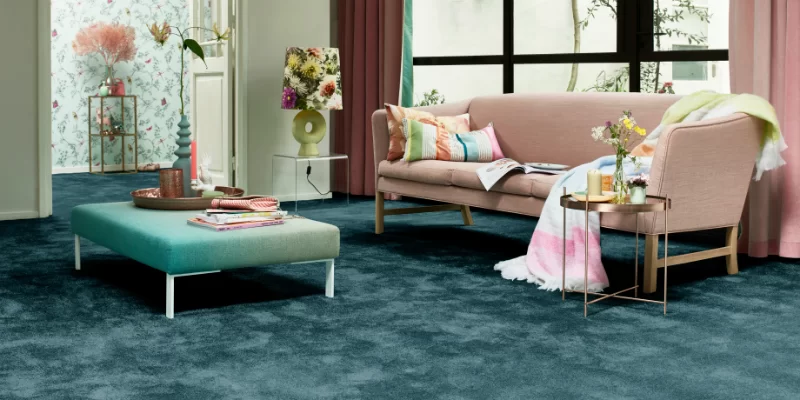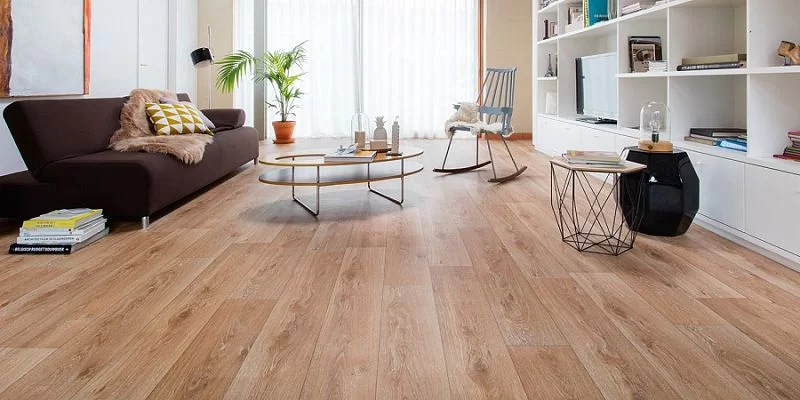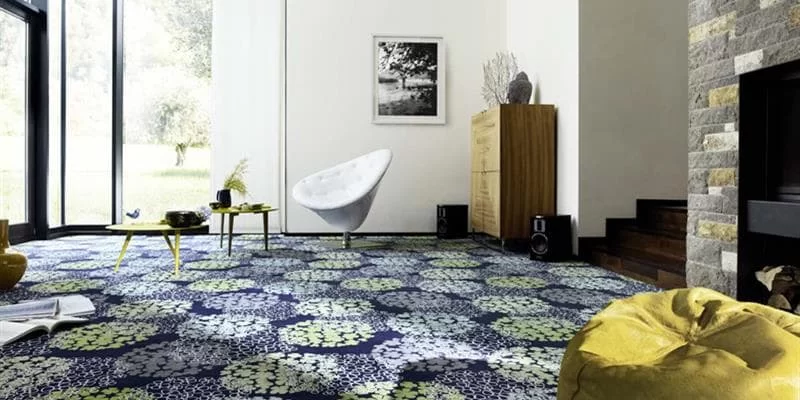
Compare carpet and linoleum | Determine the best coverage
Our experts in the field of construction and repair have analyzed the properties of two types of flooring materials — carpet and linoleum, evaluated their advantages and disadvantages in comparison, which will help you choose the most suitable one.
carpet

Floor covering that resembles a carpet. Manufacturers produce several types of carpet, differing in the material of manufacture and properties:
-
woven carpet — made on the basis of natural jute mesh fabric, to which a pile is attached, consisting of wool fibers or polymer fibers. Has increased strength; -
needle stitch — made on the basis of jute, synthetic felt or rubber. With the help of a needle of a special machine, the threads that form a pile in the form of small loops are pulled through the base and fixed on it; -
needle-punched — manufacturing technology is the same as in the manufacture of needle-stitched carpet, the difference is that in this case, serrated needles are used that entangle the fibers of the pile; -
flocked — are made using equipment that generates a static electric discharge, as a result of which the fibers of the pile take a strictly vertical position, after which they are attached to the base.
Carpet can be divided into two groups: natural and artificial. For the production of natural carpet, wool, silk, cotton, jute, linen, coconut fibers are used, for artificial — fibers from polyester, polyamide and polyacryl. In addition, the carpet is divided according to the length of the pile: with a short pile — up to 5 mm long, medium length — up to 8 mm, long pile — over 8 mm.
Linoleum

Linoleum, like carpet, can be divided into two types — natural and artificial.
Natural linoleum is made exclusively from natural materials — with a jute or linen base, on which a mixture of wood flour, linseed oil, limestone and natural wood resin is applied.
Artificial is divided into subspecies depending on the material of manufacture:
-
PVC — can be made on the basis of natural fabric (jute or felt) or on the basis of fiberglass and other synthetic materials. PVC linoleum based on foamed PVC is also produced. A material in which several different components are present is called heterogeneous, made exclusively from PVC varieties — homogeneous; -
alkyd or glyptal — it is made with a fabric base, on which a mixture of alkyd or glyptal synthetic resins is applied with the addition of fillers and dyes; -
nitrocellulose — made without a base of nitrocellulose with fillers — gypsum, plasticizer, coloring pigments; -
relin — made on the basis of rubber, covered with a layer of synthetic rubber. It can be used to cover the floors of technical rooms, garages, swimming pools, gyms, etc. It is not used for residential premises, as it is capable of releasing substances harmful to health.
The material is subdivided and marked by classes with a two-digit number, in which the first digit determines the purpose — for residential, office and commercial or industrial premises, and the second — the degree of load that the material can withstand — low, medium, high and very high.
Table of advantages and disadvantages
|
|
|
|
|
Carpet natural
|
+ environmental friendliness;
+ good heat and sound insulation;
+ the floor is “warm”, that is, it creates maximum comfort, especially in the bedroom;
|
— gets dirty quickly
— low wear resistance;
— risk of damage by moths;
— the possibility of infection with pathogenic microorganisms — mold and fungus;
— wool coating accumulates static electricity;
— high price;
— the risk of provoking allergic reactions in asthmatics and allergy sufferers;
— it is difficult to remove fatty stains.
|
|
Carpet artificial
|
+ high wear resistance;
+ there is no danger of contamination by pathogenic microorganisms;
+ easy to clean, and dirt is barely noticeable;
+ does not deform, keeps its shape well;
+ durable, retains texture and color for a long time;
+ is sold at a relatively lower price than natural.
|
— not environmentally friendly — some types of materials from which artificial carpet is made can emit substances harmful to health.
|
|
Linoleum natural
|
+ has high strength and wear resistance;
+ long service life, calculated in tens of years;
+ environmentally friendly, as it is made from natural natural ingredients;
+ easy to clean with detergents;
+ does not accumulate static electricity;
+ not flammable — refers to hardly flammable materials;
+ resistant to solar ultraviolet, does not fade in the sun and retains color for a long time.
|
— high cost in comparison with artificial;
— when the base is moistened, it can be prone to rotting;
— low elasticity, which complicates laying work;
— limited in design, does not have a wide variety in color and patterns.
|
|
Linoleum artificial
|
+ elastic, which simplifies laying work;
+ has a wide range of colors and patterns in the design;
+ has a low cost;
+ easy to clean and wash with household detergents;
+ alkyd linoleum has high heat and sound insulation qualities and wear resistance.
|
— shrinkage under the influence of high temperatures is possible;
— able to emit an unpleasant odor, which disappears over time;
— alkyd linoleum is fire hazardous.
|
The main differences between materials
The main differences between the materials are as follows:
-
have a different surface texture: linoleum is smooth, carpet is fleecy;
-
carpet has a higher cost than linoleum;
-
linoleum has a wider scope of use, carpet is limited in use for rooms with high humidity and the possibility of significant temperature changes;
-
linoleum is easier to fit;
-
linoleum has a longer service life.
How are the materials similar?
The similarity of materials is as follows:
-
can be made from natural or artificial ingredients;
-
in some types of both materials, the same components are present, for example, natural jute fabric as a base;
-
can be used for flooring in rooms of the same purpose.
Conclusions: It is impossible to say unequivocally which is better — linoleum or carpet, since there are many varieties of both materials. It is necessary to select the appropriate one based on the following conditions: the functional purpose of the room and, accordingly, the patency — the load on the floors, the mode of operation of the room — the degree of humidity, the possibility of sudden temperature changes, the aesthetic component — the nature of the interior design of the room.

Добавить комментарий
Для отправки комментария вам необходимо авторизоваться.